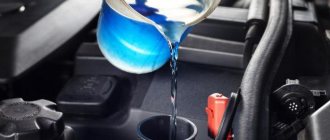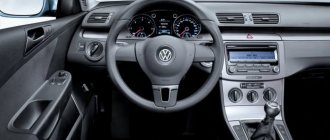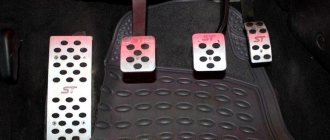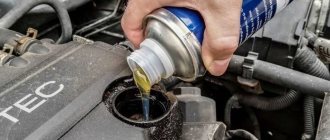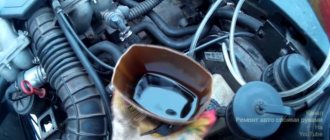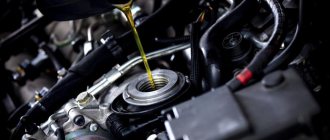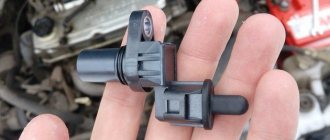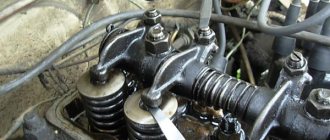For a number of reasons, cars with a manual transmission remain quite common and in demand, especially in developing countries and the CIS. The fact is that the mechanic's gearbox is simple and reliable; with proper handling and timely, high-quality maintenance, this unit can last at least 200-250 thousand without repair.
However, even taking into account the high reliability of the manual transmission, individual elements can fail much earlier. First of all, we are talking about clutch. Next we will talk about what to do if the clutch does not work, that is, how to change gears without pressing the clutch, how to engage first gear or reverse, shift to up or down without the clutch.
Is it possible to change gears without a clutch?
Let us immediately clarify that such instructions may not work with all vehicles with a manual transmission.
You should look for information on this matter for your car yourself if you are really interested in the issue. What about stopping? They are undesirable for obvious reasons. This is not a reason to skip all traffic lights and create emergency situations. You can just go in circles, find some free workarounds. What we can say for sure is that this will require a certain level of professionalism. If a stop is necessary, you will have to start the whole scheme from the very beginning. But it’s better than an accident due to an unwillingness to stop.
Adviсe
- Pay attention to the engine speed, and at what speeds, what gears can be engaged. This will help you develop the skill of driving without a clutch.
At what speed should I engage which gear?
It is difficult for a beginner to understand when to change gears on a manual. Remember the main rule for a manual transmission - the transition to any stage occurs only after the clutch is fully depressed, all the way to the floor of the pedal. Beginners often get confused, forget about the clutch or the order in which the stages are engaged (only one, regardless of whether you are going up or down). The easiest way to switch in a timely manner is based on the speed of the car. This allows you to make traffic more dynamic and save fuel.
There is a speed schedule that is easy to navigate when driving a domestic manual vehicle (listed below). Modern imported models have different parameters; for them, you should study the manual individually for each model. You can switch to the next stage when the speed of your vehicle has reached:
- At the first stage – 15-20 km/h;
- On the second – 35-40;
- On the third – 50-60;
- On the fourth 70-80;
- In fifth gear the car accelerates over 90, and you can only shift further if you have a 6 or more speed gearbox;
It is important to remember that these parameters are indicated for vehicles without cargo, trailers and for asphalt roads. If you are driving off-road, the car is loaded with things, full of passengers, or towing a trailer, then switching is done a little later. You need to let the car accelerate at the previous stage. The same rule applies when moving uphill with a steep incline.
What happens if you change gear without a clutch?
Naturally, there is no need to practice this all the time without doing anything. And you are unlikely to be able to do this intentionally and easily. A difficult task. Because the driver will encounter such serious vibration on the lever that it will immediately become clear that it’s time to end such experiments.
Still, let's not forget that gears and rims are products made of alloy steel. A person does not have much strength to “defeat” them. There is definitely a small chance that the teeth will be able to match, resulting in a gear change. But the chances of this are very small. The most important thing here is the moment of engagement of the lever with the gear. But he doesn’t exist, as you understand.
Warnings
- Please note that not all transmissions allow smooth shifting without a clutch; frequent unsuccessful shifts can cause transmission failure. Transmissions designed for heavy loads may wear out more and the gears will be more difficult to engage without a clutch. Clutchless gears work best in small cars with a conventional transmission.
- When downshifting, make sure the engine speed begins to drop before attempting to shift into gear. If you apply force prematurely, the gear teeth may be damaged.
- Shifting without a clutch is only possible when the vehicle is moving. Pulling off a car requires using the clutch.
The clutch has failed - how to get there correctly
Of course, the best option is to call a tow truck, but what to do if trouble finds you in some villages, where you will have to wait a very long time for a tow truck, and its services will cost an order of magnitude more. Of course there is a way out! Let's try to get there without the clutch.
How to start without a clutch
For a successful start, you need to press the accelerator pedal a little so that the engine does not just jerk and stall, as happens with novice drivers, but goes in first gear.
The main thing is that before starting the battery, the load on the battery is minimal, because pulling the entire car while simultaneously starting the internal combustion engine is a very difficult task even for the newest battery.
We turn off the daytime running lights, radio and other consumers of electricity. Then you need to engage the first gear and start the starter for a few seconds. In a successful scenario, the car will twitch briskly, and lightly pressing the gas pedal will not allow the engine to stall.
Then you get the opportunity to drive in first gear to your home or service station, even if your clutch fails somewhere along the road.
To prevent other road users from being too indignant at your low speed, simply turn on the hazard lights and continue driving in the far right lane so that other motorists can overtake you without any problems.
Stopping must be accomplished by moving the gearshift lever to the neutral position. Then all that remains is to brake smoothly using the standard foot brake pedal.
How to drive without a clutch
In the first part, we discussed what to do if the clutch cable breaks along the way.
The second part of the quest is to get from the parking lot to the service station or home. The rules are similar.
Here they are: 1. It is better to drive at night or early in the morning , when traffic on the roads is light. 2.Before starting to drive, start in neutral and warm up the engine to operating temperature. This is necessary so that the engine does not stall when we pull away in first gear. 3. Before we start moving, we clearly plan the route . “I’ll turn left, then I’ll turn right onto Surganov and stay in the right lane, then I’ll turn right onto Bogdanovich on Bangalore, staying in the right lane,” etc. It is advisable to think through each intersection and, if possible, avoid busy streets and traffic lights. This is why it is better to complete this quest late in the evening. 4. When planning your route, try to always take the main road . Since there is no clutch, it is advisable not to stop while driving. And if you drive on the secondary road, you will have to stop and give way at the intersection. I had 3 intersections with the main one: exit to Surganov from the courtyards, turn left from Nekrasov to Kolas and turn left in my native Borovlyany. 5. If the route starts from an exit from a secondary road, then make sure in advance that the main road is clear. If the main one is busy, wait a little until she is free. Let's arrange it so that it is free when we slowly roll up to it in first gear. 6. Well, let's start? Fuck it. Buckle up! 7. Well, now let's go! But no. Turn on the emergency lights! 8. Okay, we're ready. We set off the same way as before. We turn on the first one, turn the key and give the gas (no, no need to fart, it won’t help the grief). That's it, let's go first. 9. You will have to drive very slowly in first gear. Even at 20 km/h the engine will roar indignantly. Therefore, there is an option to enable the second one. To do this, we will drive on the first for a few minutes to ensure that the battery is charged. It will be difficult for him to turn the starter to start from second gear. Ready for second gear? Here's how to turn it on: 10. If possible, stop on a descent, or at least on a flat area. Not on the rise ! 11. Without starting the engine, turn on second gear , and then repeat the same shamanism as before. We do not spare the gas so that the engine pulls out of second gear. The engine will snort once, twice, three times and start. It will be harder to get going than with the first one. 12. The second one is much more pleasant to drive. You can accelerate to 40 km/h - and this is almost normal city speed. 13. in advance and plan the movement so that we don’t have to stop. Do you see the pedestrian? Slow down in advance and let him pass. Traffic light? Roll as slowly as possible to miss the red and hit the green. (I failed to calculate once, and I ran a red light very hard...) 14. If you had to stop at a traffic light, we start from the first one. It is advisable to plan it so that you have to start the engine only once and immediately drive through the intersection without additional stops. 15. That's all. So we'll slowly drive home. If you park, position yourself so that next time you still have the opportunity to move (don’t put your nose in the farthest corner).
And finally - the main thing. 1. while driving! You will damage the box! 2. If you stop on the rise , you won’t be able to move and you’ll lose your battery! Stand only on a descent or on a flat area. 3. Before starting the car, warm up the engine. If you can't get going, you'll drain the battery! 4. When driving without a clutch, it is very important in advance and calculate the road situation in advance. 5. Try to drive only on the main road so as not to give way. 6. Did you know that instead of turning left, you can turn right 3 times? 7. Are you getting ready to stop? Plan how you will start moving later.
Sources
- https://cardinator.ru/mozhno-li-perekljuchat-peredachi-bez-sceplenija-i-chto-budet-esli-perekljuchit-peredachu-bez-sceplenija/
- https://ru.wikihow.com/%D0%BF%D0%B5%D1%80%D0%B5%D0%BA%D0%BB%D1%8E%D1%87%D0%B0%D1%82 %D1%8C-%D0%BF%D0%B5%D1%80%D0%B5%D0%B4%D0%B0%D1%87%D0%B8-%D0%B1%D0%B5%D0%B7 -%D1%81%D1%86%D0%B5%D0%BF%D0%BB%D0%B5%D0%BD%D0%B8%D1%8F
- https://sochi-avto-remont.ru/otkazalo-sceplenie/
- https://KrutiMotor.ru/kak-pereklyuchat-peredachi-bez-stsepleniya/
- https://zen.yandex.ru/media/carsrating/kak-perekliuchat-mkpp-bez-scepleniia-i-pochemu-eto-vajno-znat-5cb588a871b26b00b3453797
- https://xn—-21-43dabppn4d4dn.xn--p1ai/%D0%BA%D0%B0%D0%BA-%D0%B5%D0%B7%D0%B4%D0%B8%D1%82% D1%8C-%D0%B1%D0%B5%D0%B7-%D1%81%D1%86%D0%B5%D0%BF%D0%BB%D0%B5%D0%BD%D0%B8% D1%8F-%D0%B4%D0%BE%D0%B5%D1%85%D0%B0%D1%82%D1%8C/
- https://xlam.wordpress.com/2007/10/23/how-to-drive-without-clutch/
Driving without a clutch: subtleties and nuances
So, as for the clutch, many drivers know that this unit is subject to significant loads during operation and may require replacement every 80-100 thousand km.
In this case, malfunctions in the clutch operation manifest themselves in such a way that the driver cannot engage the desired gear after starting the engine, gears are engaged with great difficulty, and engagements are accompanied by a crunching or grinding noise.
There are also situations when, for example, the clutch cable breaks, problems arise with the pedal assembly, etc. Driving without a clutch is also practiced in motorsports and in extreme conditions, when the driver seeks to minimize the disruption of power flow when squeezing the clutch to change gears.
In any case, if it is necessary to continue driving under your own power due to a malfunction or for another reason, on a car with a manual transmission it is possible to shift without using the clutch. This becomes possible provided that the engine and transmission speeds are synchronized.
- Now let's look at a typical case when the clutch does not work, but you need to drive. First of all, you need to start moving. To do this, with the engine turned off, first gear is engaged. Next, before you start driving without a clutch, you need to make sure that there are no obstacles in the way.
Now you can turn the key in the ignition and start the engine with first gear engaged. It is important to be prepared for the fact that immediately after turning the key the car will begin to actively move forward (for the first 1-2 seconds there will be a jerk from the starter, then the engine will start). For this reason, the gas pedal should not be pressed before starting the internal combustion engine.
After the car starts moving and the engine starts, you need to continue driving in first gear, gradually adding gas. If this is enough, then on the 1st it is quite possible to get to the repair site or parking lot.
- If you need to continue driving without a clutch with an upshift, that is, when you need to shift higher (from first speed to second, third, etc.), then you need to shift gears “up” while moving, taking into account certain rules.
If you need to increase the gear, you should remove your foot from the accelerator pedal (this will relieve the load on the transmission). Then you need to make sure that the speed is approximately the same as the gear you want to engage. To engage a gear, you will need to move the lever to the position where one or another gear is engaged. You also need to hold the gear shift lever with a little force.
The force may also differ on different cars. At the moment when the engine speed matches the transmission speed, the gear is engaged. After turning on, you can press the gas again and continue driving.
Please note that if you apply too much force, then the gear may be engaged earlier, which can cause gearbox failure, wear of synchronizers, gears, etc.
In this case, minimal effort can also cause the gear not to engage. Moreover, attempts to turn on the speed with minimal effort lead to the fact that the gear teeth also wear out.
Taking into account the above, it becomes clear whether it is harmful to change gears without a clutch. As you can see, gearbox wear can increase, especially if the driver makes mistakes when shifting.
- To downshift (downshift) without a clutch, downshifting is done in a slightly different way than upshifting. To put it simply, the gears are engaged with over-throttle.
To begin with, you need to take your foot off the accelerator pedal, then you can turn off the gear by moving the gearbox to neutral. Next, you should press the gas pedal again, raising the speed to 2-2.5 thousand rpm.
After this, when the speed drops, you need to push the gearshift lever with a little force to the position where the desired gear is located. At the moment when the engine speed is equalized in relation to the transmission speed, the desired gear will be engaged.
- Also, in some cases, it becomes necessary to engage reverse gear without a clutch. Let us note right away that without proper experience and urgent need, it is better to refuse attempts to engage reverse gear in case of clutch problems.
However, if such a need exists, then reverse gear can be engaged in exactly the same way as first gear at the beginning of the movement. First, the car should be stopped (if the car was moving forward before), the internal combustion engine will need to be turned off. Then reverse gear is engaged with the engine turned off.
After the gear is engaged, you need to crank the engine with the starter and be prepared for the car to sharply jerk back. Next, the engine should start, after which the vehicle will be able to continue moving in reverse on its own.
Engaging top gear
To engage top gear, you will need to do several sequential steps:
1. take your foot off the gas pedal;
2. turn off the gear by moving the box to “neutral”;
3. move the knob to the direction of the gear you want to engage;
4. lightly press the handle (the force can only be determined experimentally, since it is different for different cars);
5. after synchronizing the engine and gearbox speeds, the gear will engage;
6. To further increase speed, smoothly depress the gas pedal.
If you press the lever too hard, the shift will occur prematurely. With weak force, the gear simply will not engage. In both cases, this will lead to abrasion and even destruction of the gear teeth in the box.
Downshifting
A lower gear is engaged when the engine power is not enough to maintain normal movement. This happens when driving up a steep mountain, with the car fully loaded, on a difficult road surface. To shift without pressing the clutch, you will need:
1. take your foot off the gas;
2. turn off the current gear and turn on neutral;
3. Smoothly depress the gas pedal to reach 2500 rpm on gasoline engines or 2000 on diesel engines;
4. as soon as the speed begins to decrease, you need to move the handle towards the desired gear;
5. When comparing engine and transmission speeds, the gear will engage.
Not all manual transmissions have the ability to change gears without a clutch.
.
This is especially difficult to do on equipment designed for increased loads. To downshift correctly, you need to wait until the engine speed drops, otherwise you can break the transmission. You can only shift without a clutch while moving; you won’t be able to move off like that.
Features of gear shifting in manual and automatic transmissions
Today there are a wide variety of automatic transmissions; such gearboxes shift independently when the car accelerates or decelerates to a certain speed. Some have a switch (selector) that allows you to control the gearbox manually (robots), some switch only to forward, reverse and parking modes (automatic, CVT).
The traditional manual transmission, where each stage must be switched manually, remains in service. It is inexpensive to repair and operate, and allows you to fully control the car in motion. To avoid frequent mechanical and clutch repairs, you need to understand the rules and master the techniques of switching gears.
A “manual” transmission, which is called a mechanical transmission, can have 4 or more steps; the most common are 5-speed units in modern cars. Only steps intended to move the vehicle forward are considered gears. “Reverse” - the rear stage is available by default. That is, in a five-speed manual there are 5 steps to move the car forward and another in the rear.
The manual transmission and the engine are connected via a clutch. The clutch is present in robotic transmissions, only the gear selector is controlled electronically. CVTs have their own specialized clutches, which also work fully automatically. Automatic machines do not have the usual clutch; there is another device that works on different principles.
In the process of switching gears, it is necessary to disengage the clutch of the gearbox with the engine, this allows you to quickly and without loading the transmission parts to switch from one gear to another. An experienced driver knows how to feel the car, switching gears smoothly, without jerking or grinding. Beginners are faced with the problem of learning how to change gears on a manual transmission correctly, so that the engine does not stall.
Procedure
Remember what you need to do to know how to drive without a clutch:
- When the engine is not started yet, engage 1st gear.
- Check that there is no obstruction to traffic in front of the vehicle.
- Press the gas lightly and start the engine with the starter.
The car should start and start moving. Once the engine is running, turn off the starter. Now you can drive for a long time at 1st speed.
With some skill, you can shift without damaging the gearbox without using the clutch pedal. Nothing secret - when the engine pulls the car forward, the gears in the gearbox are pressed against one side of the teeth. When the power is released for a moment, the gears change the direction of contact.
An experienced car owner can use this property of the box. At this moment, you need to disengage the gears, and by synchronizing the engine speed, you can easily engage the required gear.
Let me explain in more detail:
- Accelerate the car and press the gearshift handle with your hand in the direction of turning off the speed. Do not touch the clutch pedal while doing this.
- Release the gas, the lever will turn off the gear when the moment comes to change the force of the gears.
- After a short interval, when the engine slows down, choose the moment to shift to the next gear. The angular speeds of the gears will be equalized, and the desired gear will be engaged.
Method 1 of 2: Switch Up
- As the car is moving, if you want to upshift and it is in an area that allows you to shift, take your foot off the gas pedal.
This will ease the load on the transmission. Then, quickly turn off the transmission.
- Pull or push the shift knob toward the desired gear while applying slight pressure.
Please note that the pressure on the handle is different on all machines. If you apply too much force, you will engage the gear prematurely, which will cause the teeth to wear out. If the force is too small, the gear will not engage, which will also cause the teeth to wear out.
- As soon as the engine speed matches the transmission speed, the gear will engage.
- Once the gear is engaged, you can continue driving.
Method 2 of 2: Switch Down
- If, while driving, you want to shift down because the engine does not produce the power necessary for normal movement, take your foot off the gas pedal and turn off the gear.
- Press the gas pedal to bring the speed up to 2000-2500 rpm, then release the gas.
- Then, as the rpm starts to drop, push the gear lever towards the desired gear using a little force.
- As soon as the engine speed matches the transmission speed, the gear will engage.
- Once the gear is engaged, you can continue driving.
Changing from a low gear to a higher gear
However, prolonged driving in first gear can lead to engine overheating and failure. However, it is possible to do without a clutch and still drive fully. This technique is carried out according to the following algorithm. You must first achieve the speed of shifting gear from first to second, then turn off first gear by moving the transmission lever to the neutral position. To do this, the gas pedal is released and at the moment of least resistance the transmission is switched off. In a similar way, the next gear is engaged, acceleration occurs, and so on, in a circle.
